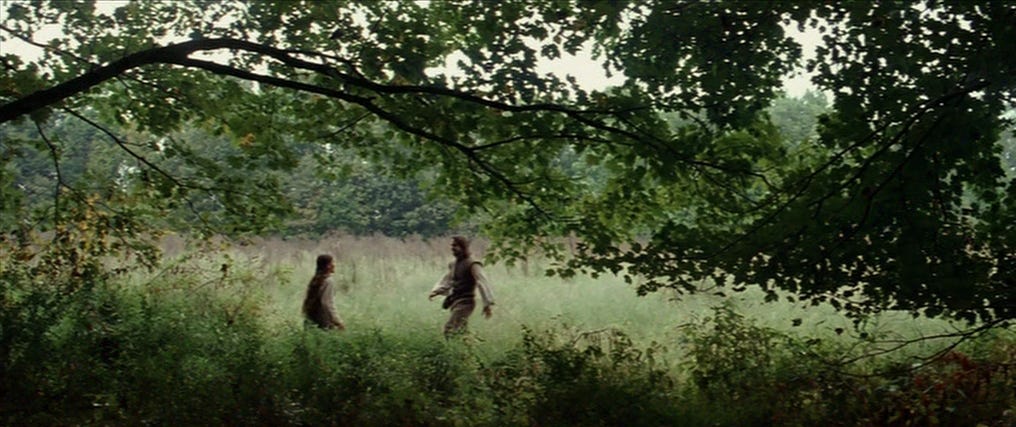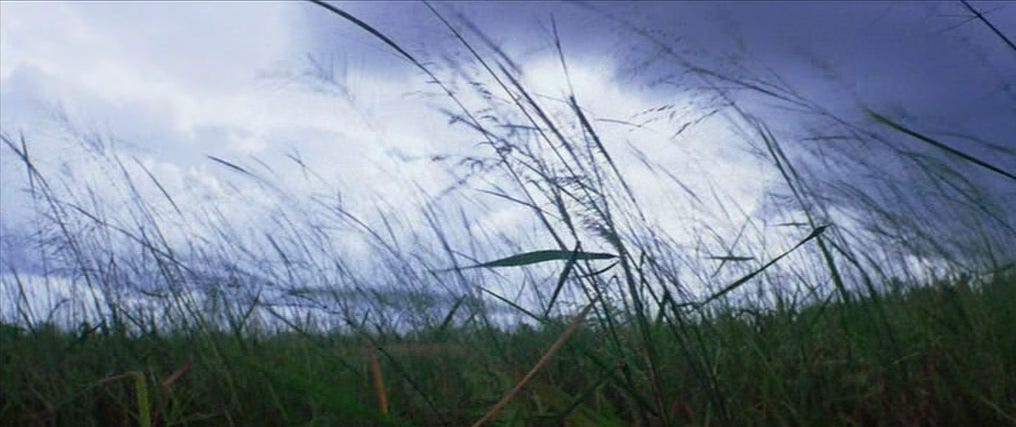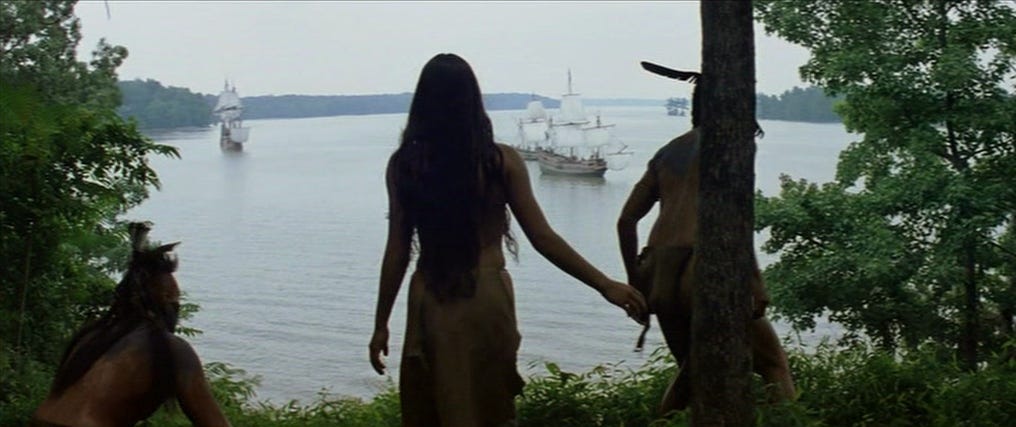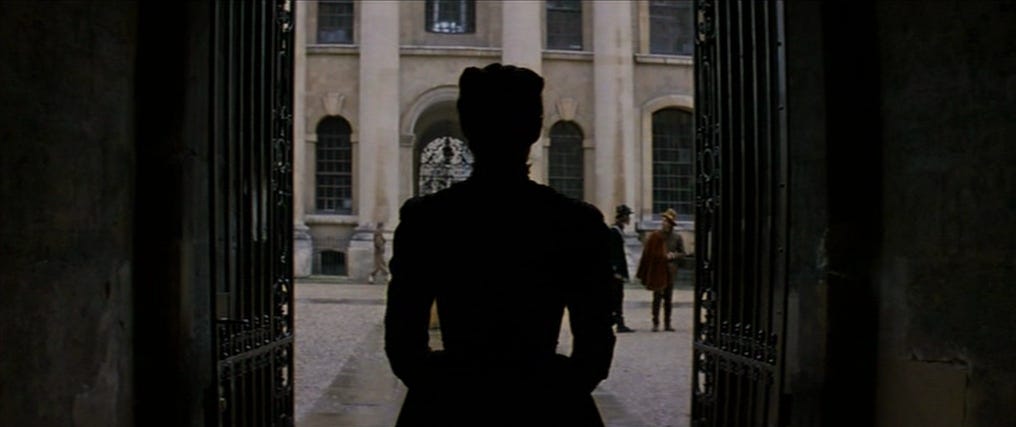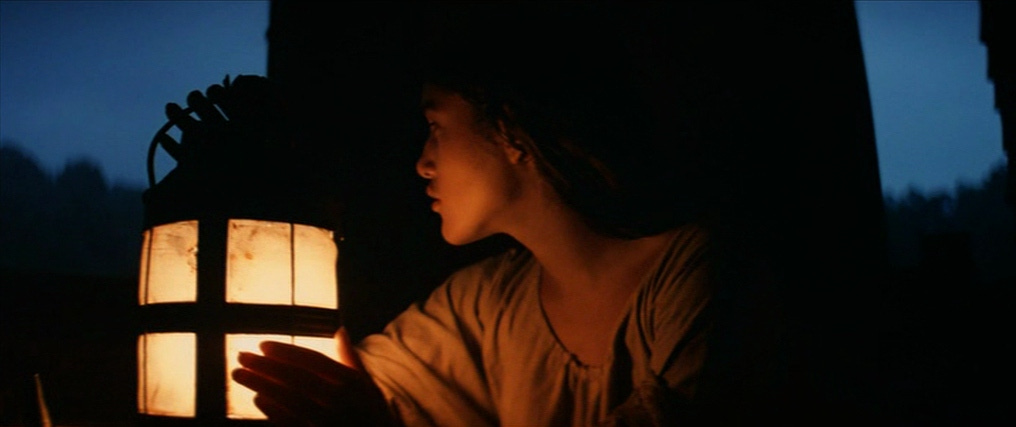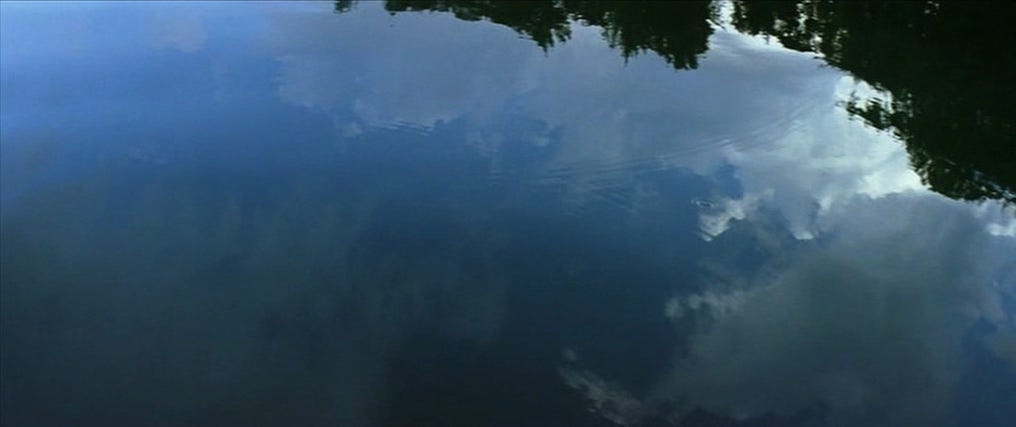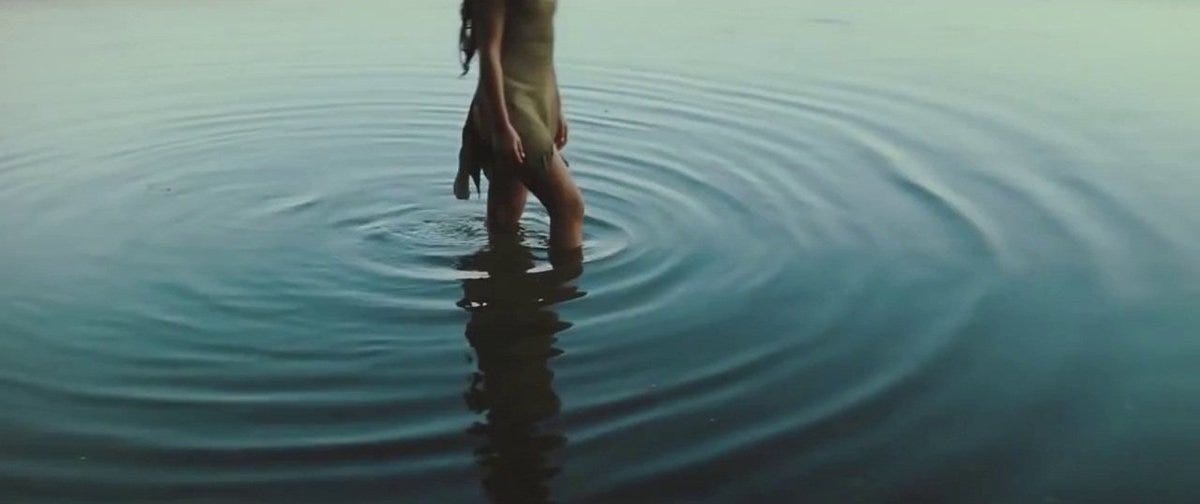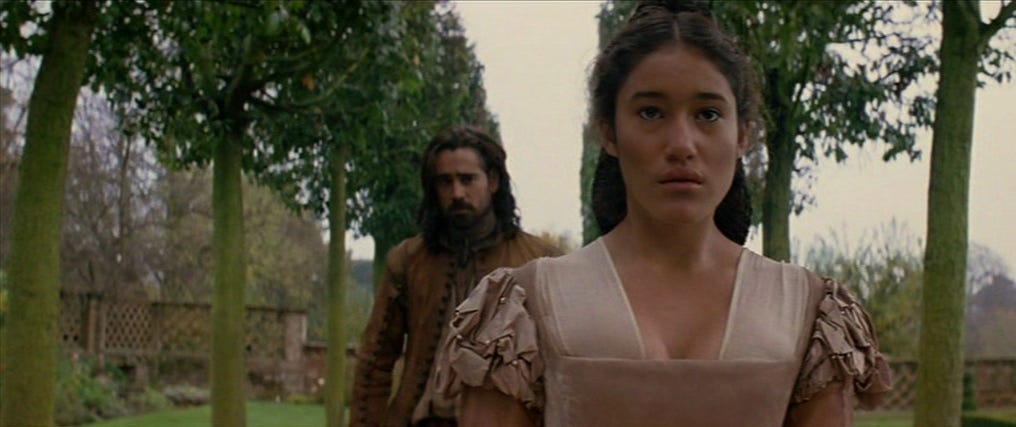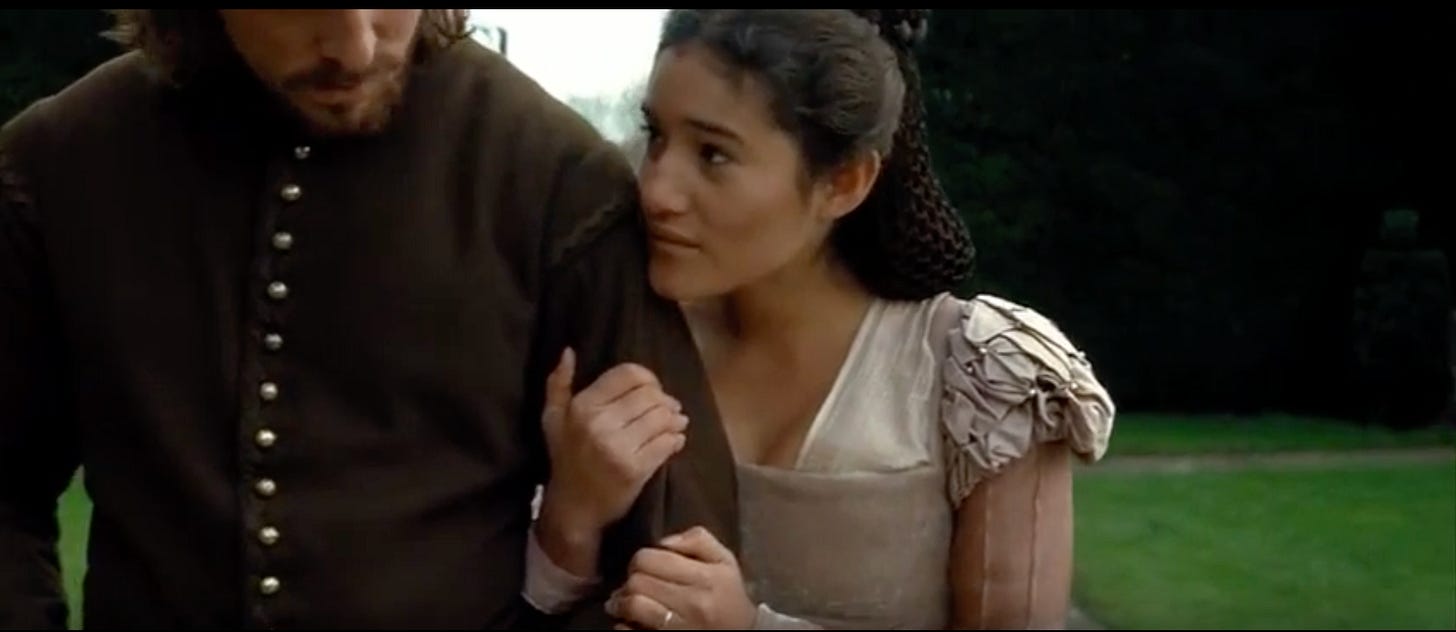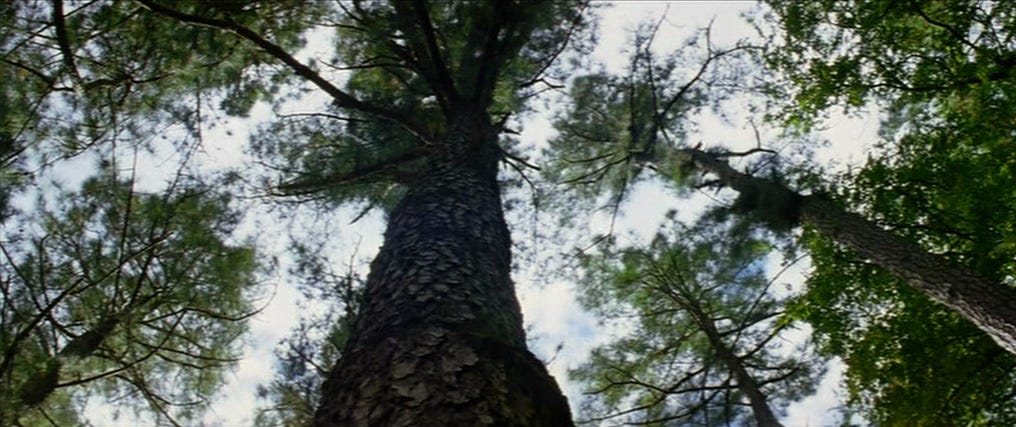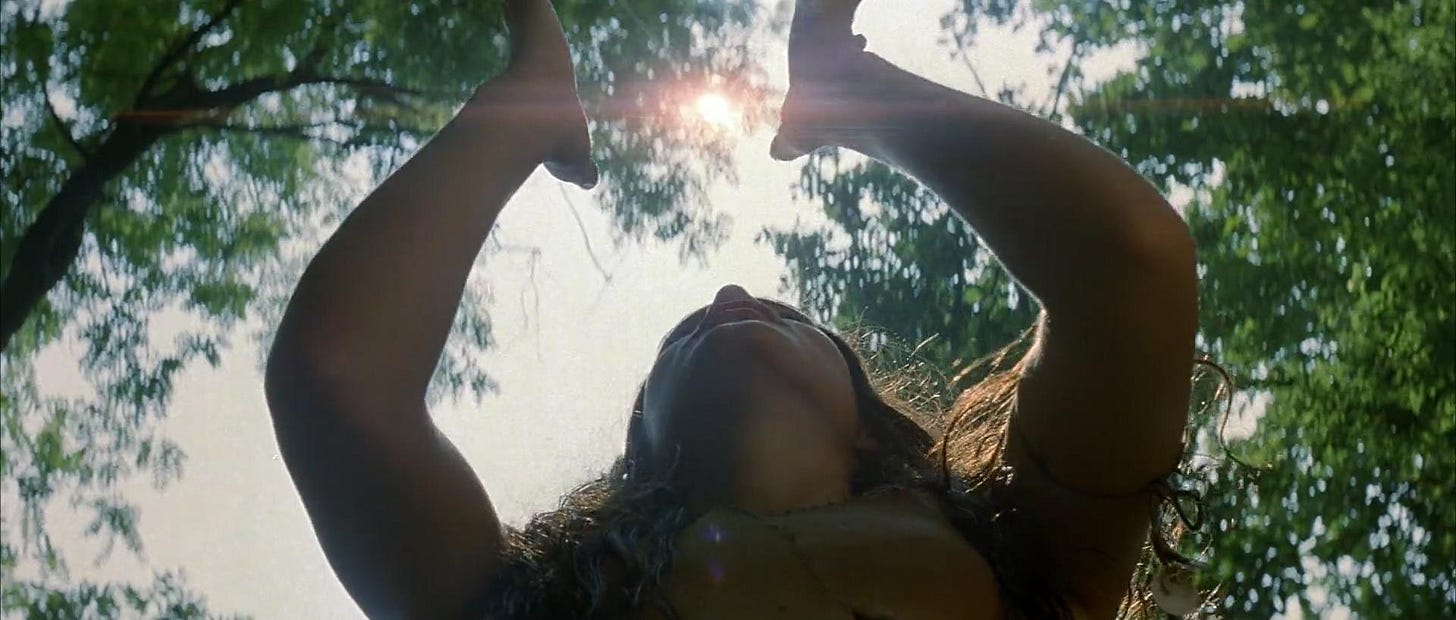This week my thesis film makes its International Premiere at the Beijing International Short Film Festival - it’s a really incredible festival lineup and a wonderful programming team, I’m very fortunate to be included! I had a chance to give a little interview about the film, and I talked briefly about my hunger for more “spiritual cinema” which I define very loosely and perhaps too vaguely as a cinema that more fully explores the connection between visual images and the divine, or images that can stir the soul on a deep, philosophical level. Moving moving images, if you will. But when I write or talk about these kinds of things, I sometimes feel a bit phony and pretentious and ultimately like I’m espousing something that might not really exist. Am I challenging filmmakers to carry out an impossible task? Is there really such a thing as a divine image in narrative cinema? Are these rhetorical questions?
Then I remember Terrence Malick.
There are certain films, and shots within films, that can change the chemistry of your brain: images that shift how you think about the world, what you think about God, love, the afterlife…. And they do all this without a single accompanying line of dialogue. When I think of the shots or sequences that have had this effect on me, they’re usually from a Terrence Malick film. A few in particular have undoubtedly changed my relationship to spirituality and nature: the final moments of Tree of Life, and a couple of moments from the film I’m writing about today, The New World.
Thanksgiving movies aren’t really a thing in the business. Of course, it’s a big release date weekend, but genre-wise, there isn’t a canon of ‘Thanksgiving Movies’ like there are for Christmas, or the July action-blockbuster, the Valentines Day corny rom-com, and so on. And there’s a business reason for this: way back when I worked at my first job in Hollywood at an international sales and distribution company, I remember my boss bemoaning having to try and sell a film centered around a Thanksgiving dinner. Still in the script stage, she dropped more than a few not-so subtle hints to the producers that they should change it to Christmas to sell better in overseas territories. All of this is to say that a good “Thanksgiving movie” might be hard to find. My number one Thanksgiving Movie rec is actually Best in Show which I turn on after watching the National Dog Show every year. But if you’re looking for something else, something richer, more filling and rewarding than even the best Thanksgiving meal, a film to catapult you into the holiday season with a sense of awe, wonder, and grace, you need look no further than Terrence Malick’s The New World.
The film tells the story of the founding of Jamestown Colony in 1607 by English settlers of the Virginia Company. Colin Farrell plays Captain John Smith, who arrives in Virginia and soon meets and falls in love with the Powhatan Chief's daughter, Pocahontas, played by the truly astounding newcomer Q'orianka Kilcher. The first half of the film centers around the clashes between the English colonists and the Powhatan and the growing relationship between Pocahontas and Smith, but then expands in scope to include England, the Old World, and Pocahontas’ later marriage to another Virginia John, John Rolfe (who I’ll just call Rolfe from now on.)
Malick’s indelible shooting and editing style elevates this tale from mere movie to mythic status, as he is quintessentially concerned more with how the characters inhabit space rather than the peculiarities of their psychology. Emmanuel Lubezki’s camera meanders gracefully while the editing skips stealthily ahead through time, wrestling in scenes that unfold memory-like across the screen… remembering words spoken but not the gaps in between them, not exactly how it all happened in sequence. Malick resists the constraints of time in favor of the impression of a single moment: where the sun lies in a specific point on the horizon, how the wind rustles in the waist-high grasses. You might leave this film with a more astute grasp of the facts and narrative of those early clashes between colonial settlers and indigenous nations, but all of that is incidental to the emotional impression the film leaves you with. It’s like Malick taps into some archaic inner eye deep within us, and shows it a glimpse of what those encounters must actually have been like: how the air might’ve felt, the cool water of the Potomac River on dry lips, the specific hue of the sun as it rose and fell and brought day to this strange new land.
This is spiritual filmmaking.
These, to me, are sacred images. But this isn’t to say Malick paints a rosy picture of American colonialism - quite the contrary, in fact. He foregrounds the violence and oppression of the colonial project both in the film’s narrative and in its visual execution: the opening scene depicts the arrival of the stiff, metallic armada of settlers and juxtaposes it with the natives, lithe and alert, waiting to greet them head on. We see Pocahontas for the first time amongst her family, communal and reverent in the face of an unknown just as foreign, before cutting sharply to a shot of John Smith standing in front of a dangling, threatening noose. He is spared from death by hanging (by his own men), but only just. Already they have brought a judicious and punishing way of life to these shores. As the Powhatans navigate through and around and within their surrounding nature, voiceovers of the settlers announce things like “We will sleep in our armor” and “Tomorrow, we will chop down every tree.”
The commentary on the oppressive and extractive presence of the settlers is deeply felt, Smith quickly picking up on how different the structures and contours of their world are (“here, none need grow poor”) and yet Malick isn’t interested in this story to litigate the rights and wrongs of history, but rather to place us deeply within this wondrous land - wondrous to settler and native alike. The other side of this wonder is depicted in the latter half of the film when Pocahontas voyages to England with her now-husband John Rolfe, played by Christian Bale in one of his most tender roles. When she arrives, rather than showing London as a dirty, suffocating city lacking the true warmth and vitality of the new world, Pocahontas is just as rapt with amazement as her former (and truer) love Smith was when he arrived in Jamestown. This is important because it eviscerates the suggestion that she and her people are mere Noble Savage tropes, a trap I feel like a lot of artists tackling this subject matter fall into.
On this point, I love how Tom Gunning put it in his essay included in the Criterion Edition of the film:
“The film includes two complementary voyages of discovery: not only that of the English to Virginia but also that of the Virginian Pocahontas to England. The environment of London in the era of Shakespeare, Francis Bacon, and John Dee may offer some compensation for the horror wrought by imperialism. If the New World became the site of genocide rather than a new Garden of Eden, Malick nonetheless finds value in the confluence of technology and art that Heidegger calls by the Greek term techné. Acknowledging the betrayals and exploitation that founded our modern world, Malick’s cinema also understands that true tragedy forbids simple nostalgia for a lost world.”
Malick’s sincerity in staging these landscape-encounters, both New World and Old, proves that he is interested in the unique offerings of cinema to get closer to a common, shared humanity rather than using the medium to exploit our differences. He gently probes his deep philosophical questions from all sides, literally and figuratively, circling landscapes and figures through a steady-cam’d lens and a fugue of voiceover and diegetic dialogue. From his shooting style to his editing rhythms, he isn’t interested in piecing together history, but rather getting closer to the truth of a singular moment of the human experience. He lingers on characters observing one another for beats too long. He cuts from diegetic sound to a muted voiceover in the pinnacle of violent action.
He is obsessed with the present moment, using the language that only film provides to circle the impenetrable center of time. His films are elliptical, returning to a specific question over and over again: in The New World that question is “Who are you?”
“What voice is this that speaks within me?”
When she first meets Rolfe, Pocahontas, learning English, asks him:
“What is a day? What is an hour?”
What is at the center of things?
Pocahontas, later: “I am. I am.”
In Book XI of Augustine’s Confessions, ‘Time and Eternity’, the Saint wrestles with the nature of time and the impossibility of “The Present”:
“The present occupies no space… Who will tell me that there are not three times, past, present, and future, as we have learned when children, and as we have taught children, but only the present because the other two have no existence? Or do they exist in the sense that, when the present emerges from the future, time comes out of some secret store, and then recedes into some secret place when the past comes out of the present?
and then:
"If future and past events exits, I want to know where they are.”
The similarities in these questions, Augustine’s and the characters of the New World signify to me a deep spirituality in Malick’s work, one I find particularly Christian, although I don’t know anything definitive about his actual religious or spiritual life. I don’t know how to describe certain sequences other than that they’re an embodiment of pure love: how it can’t quite be expressed by language, how words fail us in a way that touch, vision, and seeing don’t. How there is a voice that exists deep within the roots of our being that none of us can explain, least of all the people who most inquire after it.
This is sort of what I mean by sacred images. The New World is a film, I think, that shows that while language provides the structure and foundation for humanity, it is not our essence. If language is deconstructed, if we get rid of words, there will still be so much left.
There are a few landscape shots that we don’t immediately recognize are actually reflections of the earth in water - a river framed by trees that starts to undulate with the current, a sky that fractures into a puddle when a pebble is thrown into it - and while thinking about some of them, that old adage about the man who dreamed he was a butterfly popped into my head:
“Once upon a time, I dreamt I was a butterfly, fluttering hither and thither, to all intents and purposes a butterfly. I was conscious only of my happiness as a butterfly, unaware that I was myself. Soon I awaked, and there I was, veritably myself again. Now I do not know whether I was then a man dreaming I was a butterfly, or whether I am now a butterfly, dreaming I am a man.”
― Zhuangzi
I think these reflection shots embody this tendency we have to put too much emphasis on language as the only means to communicate: we are convinced of its supremacy, but are completely shaken when something as small as a pebble causes the whole image to tremble and crack. Funnily enough, this exact story of the butterfly is referenced by Hugh Grant’s character in the new movie Heretic, which I saw last weekend - it’s a great film, and I’ll write about it a little next week.
Although I see a lot of religious themes at play in Malick’s work, he also insists that a religion devoid of selfless love is deadly: early in the film, a Jamestown settler, clearly in the throes of starvation and insanity, shouts and spouts Old Testament verses threateningly to everyone around him. Real spirituality, according to Malick, requires an everflowing fountain of love - a love that regenerates, like nature, continuing to give even when so much has been taken from it. Devoid of this constant regeneration, the religious man loses his soul, and the earth its center.
On this note of love, my mind constantly circles back to two scenes in particular in the film: the first showing the burgeoning love between Pocahontas and John Smith. They wander in a gorgeous field of yellow flowers, the afternoon light fading imperceptibly as they try to communicate their love for one another. But while it is incredibly romantic, there’s also a palpably deep insecurity to it…
“Am I as you like?” Pocahontas muses in voiceover.
Smith: “I am truly not the man I seem to you to be,”
Pocahontas in voiceover: “What does he say?”
There’s a desperation for the other to complete them, to validate them and to finally reveal what lies in the center of what they’ve been circling: the final piece in the puzzle of “who am I?”
But a contrasting idea of regenerative, patient love is ultimately fulfilled by how the central tension in the film resolves itself. Pocahontas finally learns that Smith, her first, true love is still alive, having chosen to embark on new adventures overseas, and not dead as she had been told many years ago. Towards the end of the film, she is reunited with him at the home she and Rolfe are now living in in England.
Smith tells her that he regrets choosing his career as an expeditionary captain over her. She nods to him, tenderly but inscrutable, before turning away and walking back towards the house. Then, we cut to her standing up in a tree, alone, pondering - still inscrutable. Rolfe is then seen inside the house, ostensibly looking out onto the pair, and his head falls into his hands in despair as he anticipates the inevitable conclusion that his wife will ultimately choose Smith over him. He knows her love for Smith has not abated, despite the fact that she has since married Rolfe and borne their son. In a classic Hollywood ending, this would be the end of Rolfe’s and Pocahontas’ story, the re-ignition of her first love, and the urgent continuation of their quest for completion that only “True Love” promises.
After this shot of Rolfe, exhausted and extinguished inside the house, we cut to a figure walking outside - and maybe I am misreading this moment, but it appears to me the figure is Smith, who we’ve just seen in a similar position (facing away from the camera, walking through the English gardens).
Pocahontas approaches the figure from behind.
From the front, we then cut in close as her hand reaches to embrace the figure. The frame then expands, ever so slightly, to reveal who it is looking down at her: it’s Rolfe.
Despite Smith’s miraculous return to her life, Pocahontas has, for now, refused to answer the urgent and intoxicating call to return to the wilderness, so to speak. She refuses to return to the blinding task of definitively answering the question her soul sings (Who am I?) Because as we grow older we realize, of course, that no one can answer it: not our soulmate, not our truest or first love, and least of all, ourselves. A love built on an assumption that that question should be answered is built on quicksand: you’ll need a nearby tree branch to grab hold of sooner or later. Love that is self-sustaining can be found only with a person who most enjoys circling the question alongside you.
Pocahontas chooses Rolfe, who came into her life when she was at her lowest, who provided for her when it was clear she wasn’t his to provide for. “He is like a tree,” she muses early in their relationship, still deep in the throes of heartache, “I lie in his shade.” There is no desperation now, no searching and seeking and hunger. There is shade. There is rest. There are green pastures, and still waters.
And then, in the triumphant final visual sequence of the film, Malick shows us some of them.
Happy Thanksgiving!





